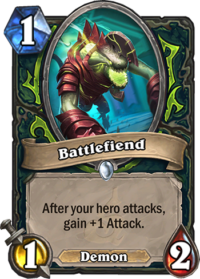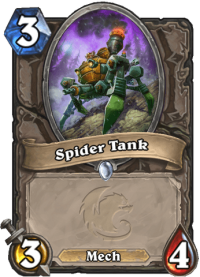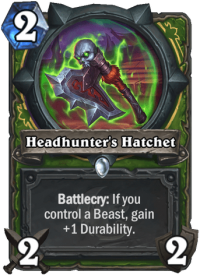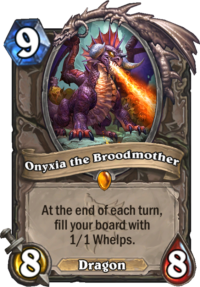With the new Core set giving all Hearthstone players 235 cards for free in the next rotation, building budget decks for Hearthstone is about to change forever. Previously, the only free cards you had access to were the Basic set, some Demon Hunter cards, and some adventure cards, and a brand new player had to go looking for most of those, you were not exactly guided to them. Sure, you also got some packs for free every now and then, and you could roll some sweet cards from those, but you might also get some completely useless cards.
Overall, the power level of the Core set cards is higher than the old Basic set and in some cases higher than the old Classic set, too. There is support for many different archetypes in the Core set, but what if you’re just starting out and need a deck? Can you build a deck from the Core set cards alone?
I journeyed to the depths of our deck builder to find out, and here are some thoughts about the Core set and of course some actual decks!
Keep in mind that cards that will be updated in Core Set still show the current, live versions. We’ll update them on the website when patch 20.0 releases.
Building a Budget Demon Hunter Around the New Core Set
Here is the first Core-only deck that I built! It might not look like much, and… OK, it is not much. Turns out that 235 cards are not really enough to give ten classes tools to build full decks. Or rather, it could be enough if all the cards were good, but they are not.

The first problem I ran into was finding good one-drops. For a fairly aggressive deck, I would usually look for either six or eight one-cost minions to ensure a strong opener. As an upside, each class typically has a good one-cost minion in the Core set, and Demon Hunter has Battlefiend, which is a great minion that sees a lot of play in the current Aggro Demon Hunter decks. Demon Hunter also has Crimson Sigil Runner, but you really want to play it when it is in Outcast position so that you get to draw a card. That’s it for the class one-drops, there simply are no more class-specific options.
Looking at the pool of Neutral one-drops, there are several in the Core set, but most of them are no good. Argent Squire works for decks that can buff it, which Demon Hunter cannot do. Arcane Anomaly could work in a spell-heavy deck, but there are not enough spells for any class in the Core set alone to make it worthwhile. There are not enough Mechs to make Cogmaster work either. By and large, the available one-drops need more support from outside the Core set to be worth including in a deck.
I was left with only two Neutral one-drops that I considered viable for Demon Hunter: Worgen Infiltrator that can often ensure good trades or face damage thanks to its Stealth ability and the newly-Rushing Stonetusk Boar that can be used to immediately compete for the board. Would I use either of these cards in Demon Hunter if I had a choice? Not really, but they were the best the Core set offered.

There are similar issues at various mana slots for all classes. Three-drops were especially painful for Demon Hunter, as the admittedly excellent Gan'arg Glaivesmith is not something you always want to play on three when it is not in Outcast position. This left me with Jungle Panther and Spider Tank as my three-cost minions. Neither is a bad card. Both have seen mainstream play during some eras of Hearthstone, but for the current power level, they feel lackluster at best.
There are also some feel-bad moments when you cannot justify using some of the few fancy cards you have access to simply because you cannot support them. For Demon Hunter, it is hard to have enough Outcast cards in your deck from the Core set alone to truly support Kor'vas Bloodthorn. I put it in regardless because none of the other two-drops were better even without Outcast support.
While the Core set Demon Hunter is an aggressive deck, it is hard to build a truly competitive pure aggro deck from the Core set cards alone. That’s why the deck also includes some healing and some more expensive finishers in the form of Warglaives of Azzinoth and Illidari Inquisitor.
However, Core set still offers a good foundation to build on. In order to demonstrate this, I looked into what would happen if I added nothing but Common cards from other Standard expansions (Ashes of Outland, Scholomance Academy, and Madness at the Darkmoon Faire) to the pool and tried to build a deck from there.
This immediately opened up two paths: the deck could be turned into a pure aggro deck, or I could fully pursue the Outcast synergies with cards such as Illidari Studies, Redeemed Pariah, Dreadlord's Bite, Line Hopper, and Vilefiend Trainer added to the mix.
I first tried to build a deck with the Outcast synergies like Blizzard expects me to do, but that approach has failed to work in real life so far. Even the snowballing ability of Redeemed Pariah has generally been too weak compared to how hard other decks can snowball their growing threats.
Turning to pure aggro produced a deck that I feel happier with. Threats from the start, additional reach with Relentless Pursuit, more card draw thanks to Manafeeder Panthara and Acrobatics, even some buffs with Wriggling Horror and tricks with Frozen Shadoweaver. And remember, this was done with nothing but Common cards added on top of the Core set.
I still wanted to take this further, though. What if I added Rare cards to the pool as well?
Rare cards open up even more options for Outcast and Aggro, but they also open up a brand new archetype: Soul Demon Hunter. With the addition of Soul Shear, Shardshatter Mystic, Bladed Lady, and Skull of Gul'dan, we can build a slightly slower Demon Hunter deck that can also play a defensive game while using Hero attacks to pressure the opponent. We can also bring back Illidari Inquisitor that is too expensive for well-tuned aggro decks, and enjoy some sweet finishers that make Hunters green of jealousy.
This Demon Hunter case study illustrates how the Core set functions: you are quite limited if you try to build only with the Core set, but adding even cheap cards from the expansions opens up multiple potential archetypes to explore. In the case of Demon Hunter, you can build three different archetypes – Aggro, Outcast, and Soul – using nothing but Core set cards, Common cards, and Rare cards: no Epic cards or Legendary cards from the expansions are needed.
Of course, we still have Forged in the Barrens coming, so many things will change, including what tech cards you will want to use in the new meta. Nonetheless, the Core set seems to provide a solid baseline, at least for Demon Hunter. But what about other classes?
Building a Core Set Beast Hunter
The only Hunter archetype that you can build from the Core set alone is a Midrange Beast Hunter. There is not enough explosiveness to go for pure aggro, and there is not enough Secret support to go for a Secret Hunter deck without adding some good cards from the expansions, like Inconspicuous Rider and Petting Zoo.

Ironically, the problem you’ll run into when building Beast Hunter is that there are not enough Beasts in the Core set. There are only two one-cost Beasts in the set, Webspinner and Stonetusk Boar, so it can be difficult to reliably activate your Headhunter's Hatchet early in the game. It can also be difficult to get full value from Scavenging Hyena without more Beasts in the deck.
That said, the midrange Beast package of Bearshark, Stranglethorn Tiger, and Savannah Highmane is kind of impressive, and you even have an excuse to put King Krush in the deck as a finisher.
I would not take this deck for a Legend climb, but it has its upsides.
Core Set Token Decks: Paladin and Druid
Paladin and Druid have tools to build token decks from the Core set:
The Paladin deck is able to make some use of Silver Hand Recruits with Warhorse Trainer and Stand Against Darkness, but I don’t think you can afford to include Pursuit of Justice without additional means of summoning Silver Hand Recruits in the deck. You need a way to regain the tempo lost to playing a spell that does nothing later on and summoning one Silver Hand Recruit at a time from your Hero Power is not it. As you add more synergy cards, Pursuit of Justice may become viable, but when working with the Core set alone, it seems weak.

There are not a lot of token generators in the Core set, so we’ll make do with what we’ve got: Grim Necromancer and class cards for tokens, Argent Squire and Annoy-o-Tron for their Divine Shields that help them survive to be buffed, and Raid Leader and Stormwind Champion for board-wide buffs. Onyxia the Broodmother provides one more late-game token-generator that has to be answered or it will keep generating new boards.
Is this strong enough to truly compete on the ladder? From that perspective, I don’t think any Core set decks can be strong enough, but it definitely looks like a playable deck with a coherent game plan and a smooth curve. That is something you could not build from the Basic set.
The Druid Core Token deck uses many of the same tools: Grim Necromancer and Onyxia the Broodmother for the tokens, and Argent Squire and Annoy-o-Tron as early-game Divine Shield minions.
However, Druid also has some tricks of its own with Soul of the Forest giving the board more survivability and Cenarius able to give a nice late-game buff, potentially as a finisher.
Core Set Control Decks?
The Holy Grail of budget decks in Hearthstone is the budget control deck. It has been challenging to build any reasonably-priced control decks in the game, and the closest I’ve got to budget decks is the inclusion of a few Epic cards without any Legendary cards, and even that is a huge struggle.
Now, the Core set provides Warlock and Warrior with a number of control tools. Warlock gets the only Hero card in the Core set with Lord Jaraxxus and it also gets Twisting Nether, Hellfire, and buffed Drain Soul and Siphon Soul. Warrior gets Brawl, Shield Slam, Execute, and Shieldmaiden.
After closer examination, I believe Warlock is the easier class to build a budget control deck for. Warrior might also work, but it needs a good win condition, probably multiple big Dragons, whereas Warlock gets a win condition in a box with Lord Jaraxxus combined with easy card draw with the Warlock Hero Power until you get to Jaraxxus.
Building a control deck with the Core set alone is an ambitious goal, and I think the deck falls a little short of being viable, even though it has a lot of good elements to it: there is plenty of single-target removal, there’s some healing, there’s some hard removal, and there’s Lord Jaraxxus at the end, not to mention the spectacular Alexstrasza the Life-Binder.
Looking at old dust prices, that’s a 7240 dust deck that is available to all players for free by the way!
Adding just a few rare cards can transform the deck into this:
I would consider taking this deck to the ladder right now if the buffs were live. It can handle tons of token boards and also some individual big minions while having tech cards for weapon removal and silence. There are six Rare cards and four Common cards outside the Core set in the deck for a grand total of 760 dust.
Of course, Forged in the Barrens will change the meta, but I have never been this optimistic for budget control decks.
Can You Build Decks With Only Core Set Cards?
Well, yes, but actually no.
You can build decks that are far better than what you could ever build with the Basic set, but the Core set is still thin. You can often find one good card for something in the set, but for consistency, you would want two or three. This means that decks built from the Core set alone have to use many weak cards alongside the strong ones. With a perfect draw, you only get the strong ones and can curve out perfectly with them, but most of the time you will have clear weaknesses in your turns.
When looking at cheap decks from a slightly wider perspective, this is still great news. You get one strong card for something from the Core set, and much of the time you can pick up another from some expansion as a Common or at most a Rare. We are about to enter an era where lots of cheap and strong decks can be built thanks to the foundation provided by the Core set, even if the set is not quite strong enough to stand alone.
Leave a Reply
You must be logged in to post a comment.





























































































I’m excited for all the new stuff coming to the game. I also wonder what the new player experience is going to be like? There are a lot of classic packs given out for those first quests. Surely they won’t be classic packs anymore, right? Latest expansion packs? Year of the Phoenix packs would be nice. So with the first level of the track rewards, new player deck, beginner rewards, and core set hopefully there is enough to get a new player competitive and able to complete quests for that sweet sweet gold.
Good article but why would you ever use King Krush instead of Alexstrasza the Life-Binder? Both are 9 mana 8/8 but Alexstrasza goes through Taunt, King Krush doesn’t. On top of that Alexstrasza can heal too!
Fair enough. The Dire Frenzy synergy probably is not enough of a reason.
I avoid building decks most of the time, but changed the basic sets here and there over the years. So I just hope I’ll be able to reset those to the new base class sets.
Point 1.
Are we agreed Hunter would absolutely own a core only meta?
Point 2.
Should I dust my current classic and basic cards?
1. We haven’t see all FitB cards. It may be more meta than you know.
2. Depends. If you play Wild, (or plan to play Classic Mode) you should not dust anything but the bad cards that probably won’t see any play.
If you don’t play WIld or maybe just want to see how Classic Mode works, hold on to it for about a week (maybe), then dust everything.
About dusting basic cards, there’s a lot of assumption going whether you can dust it or not, but it’s not clear yet as no real info about it mentioned anywhere.